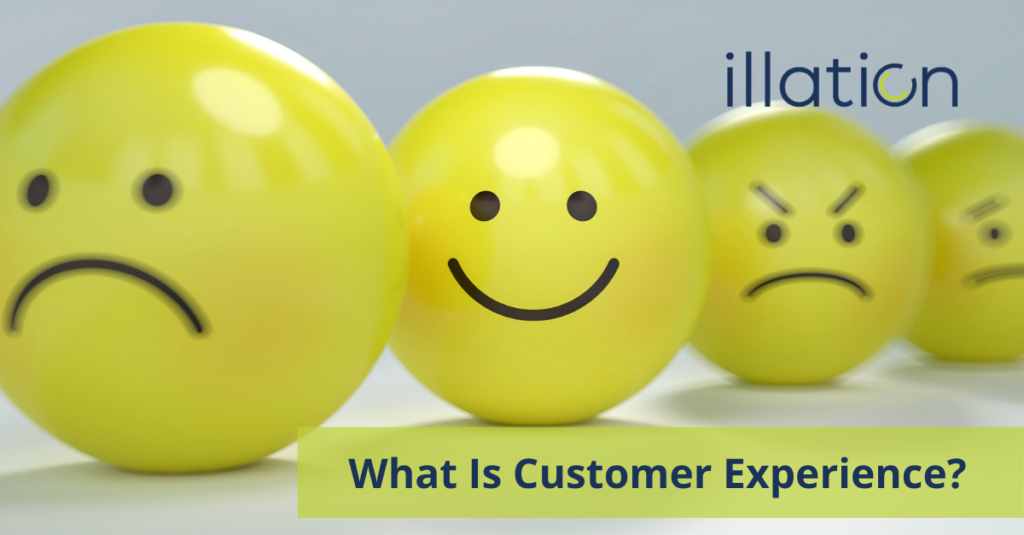Customer experience is a term that’s widely used in business nowadays. But what exactly does customer experience mean? It’s easy to look a term like customer experience and assume it’s self-explanatory. However, when it comes to defining what customer experience is about for your business, there’s more to consider than just the term itself.
What Is Customer Experience?
Customer experience (or CX for short) is a term used to refer to how customers perceive your company. Every single interaction your company has with its customers and prospects can form part of your company’s CX.
From how you present your brand, to how your employees interact with customers, it all forms part of the larger customer experience you’re offering.
Your company can improve its CX by making sure you live up to your customers’ expectations. In every stage of the buying process, customers expect you to be available for assistance.
Prospects and leads might need your guidance on what products and services you have available that best suits their needs. Existing customers, on the other hand, will expect you to be available to answer questions that enable them to get the most out of your product or service.
Why Is Customer Experience Important?
Good CX is a cornerstone to successful business. Having a well-planned CX strategy assists in both customer acquisition, as well as customer retention.
It’s a known fact that customer retention delivers better return on investment (ROI) in terms of budget spent as opposed to customer acquisition, but both are fundamentally important for business growth.
New customers encourage business growth, whereas loyal customers encourage repeat business for sustainability.
How Is CX Strategy Success Measured?
There are multiple key performance indicators (KPIs) your company can use to measure the efficacy of its CX strategy.
Some KPIs focus on customer retention, satisfaction and loyalty. Other KPIs focus on acquiring new customers and improving customer engagement rates.
“From leads, to loyal customers – every stage of the buying process can be included in your CX strategy and measured with KPIs specific to that phase of the customer life cycle.”
Different KPIs can be used during different stages of the customer journey. From leads, to loyal customers – every stage of the buying process can be included in your CX strategy and measured with KPIs specific to that phase of the customer life cycle.
Ideally, you should have all the necessary KPIs you can measure how each interaction customers (or potential customers) have with your brand influences their experience of dealing with your business.
The means by which you acquire KPIs will differ. In the initial stages of marketing, CX can be measured through metrics like website bounce rates and by measuring the ROI on marketing campaigns.
As customers advance down the acquisition funnel, measuring the efficacy of your CX strategy can start to seem more complex. You’ll no longer be able to measure direct traffic to your website, the effectiveness of your marketing campaigns and customer engagement via your social media channels.
Instead, you’ll need to rely on customer feedback to measure how well your CX strategy is performing.
Important KPIs for Customer Retention
Customer retention and loyalty are vital to the sustainability of your company. There’s no use putting in effort to constantly win over new clientele, if a bad customer experience leads to low customer retention rates and poor brand loyalty.
“It’s estimated that the cost of acquiring a new customer is up to 5 times higher than the cost involved in retaining existing customers.”
As mentioned, ROI for existing customers tends to be much higher. It’s estimated that the cost of acquiring a new customer is up to 5 times higher than the cost involved in retaining existing customers.
Considering this, obtaining the necessary data to measure the effectiveness of customer retention in your company should form a big part of your overall CX strategy.
Customer Satisfaction Index (CSAT)

Your Customer Satisfaction Index score is measured as a percentage – where 0% is obviously the poorest possible score and 100% indicates extremely satisfied customers.
You can obtain your CSAT score by setting up customer satisfaction surveys and questionnaires. Once you’ve measured the number of positive responses compared to negative ones, you can calculate your CSAT score.
Most commonly, feedback to calculate your CSAT is derived through simple ratings from customers after interactions with your company. For instance, customers who submit tickets or complaints can be asked to rate how well their queries were resolved on a scale from 1-5, or a scale from ‘very bad’ to ‘excellent’.
Using the feedback from surveys, CSAT can be calculated as follows:
Number of positive responses / Number of total responses x 100 = CSAT
As an example, if a company sent out a questionnaire to 120 customers and received 40 negative and 80 positive responses then the CSAT can be calculated as follows:
80 / 120 x 100 ≈ 66.7%
The great thing about measuring CSAT is that it’s a simple KPI to measure. You simply need to have a system in place that allows customers to rate their experience with your company.
Net Promoter Score (NPS)

Under the Net Promoter Score, your customers can be classified into three different sections:
- Promoters (answer 9-10): These are your most loyal customers who are enthusiastic about your brand and gladly recommend your company to others.
- Passives (answer 7-8): While passives are usually quite satisfied, they won’t act as brand ambassadors for your company. They’re also more easily persuaded to move their business elsewhere if they feel an offer is attractive enough.
- Detractors (answer 0-6): This classification is reserved for unhappy customers who will actively prospect to move away from supporting your business and harm your brand through negative word-of-mouth.
The Net Promoter Score will range between -100 and 100. It’s calculated by subtracting the percentage number of detractors from the percentage number of promoters.
If all your customers are detractors, you’ll score a low of -100. Conversely, you’ll score 100 if all your customers are promoters.
As an example, let’s say you sent out an NPS survey and got 150 responses that were divided as follows:
- 60 Promoters = 40%
- 50 Passives ≈ 33.3%
- 40 Detractors ≈ 26.7%
40 (% of promoters) – 26.7 (% of detractors) = 13.3
In the example above, your NPS would be 13.3. For the purpose of calculating your NPS, passives are left out when calculating your final score – effectively pushing your score closer to 0.
Customer Churn Rate
Customer churn rate (also called customer attrition, defection or turnover) refers to the rate at which customers stop doing business with your company. Churn rate can be calculated by looking at how many customers left your company during a set time period – like during a quarter, half-year or year.
To ensure company growth, your company must have a higher rate of customer acquisition than churn. Simply put, you need to get new customers at a faster pace than you lose existing ones.
Churn rates are especially applicable to industries that operate on models that make use of ongoing business agreements. Examples include telecommunications and connectivity providers (ex. mobile or internet providers), as well as companies operating within industries like insurance, banking and other financial services.
There are different ways you can measure customer attrition:
- Just count the number of customers you lost within a set period
- Calculate the percentage of customers you lost within a specific period
- Establish how much revenue you lost during a period as a result of churn
- Calculate the percentage of revenue lost within a set period as a result of churn
The simplest way to measure customer defection, is by looking at how many customers stopped doing business with your company. This is also easiest to compare to your customer acquisition rates. However, determining attrition rates in terms of revenue is useful as an analytics metric if you need insight regarding the financial well-being of your business.
Creating Better CX Through Technology
Creating a positive a customer experience is hardly a new concept in business. However, the face of CX has changed in recent years.
As technology develops, businesses are able to take advantage of emerging technologies to offer better experiences to customers.
Processes that required human resources to operate in the past, can now be automated. A simple example of this; satisfaction surveys can automatically be sent to customers after a ticket is resolved to obtain feedback.
Complaints and queries can also be ‘pulled’ from multiple channels where customers interact with your business (ex. email, social media, instant messengers etc.) and be automatically integrated into a single dashboard from which agents can work to resolve tickets. A solution that allows for CX management in this way is called an ‘omnichannel’ solution.
“Many companies are employing customer self-help options through the use of AI systems such as chatbots to answer common customer queries automatically.”
Self-help options are also a great way to minimise workload on personnel. Many companies are employing customer self-help options through the use of AI systems such as chatbots to answer common customer queries automatically.
Furthermore, many tools are emerging in the market to help improve customer engagement analytics.
With such a broad range of options to choose from, almost any business can now have a CX management solution specially built around its specific needs.
Through advanced CX technology, metrics and analytics can be automatically calculated as well. This allows for an in-depth understanding of how CX strategy can be improved.
Conclusion
CX strategy and management can seem intimidating to navigate. Now more than ever, businesses are required deliver a customer-centric experience in order to compete within the market.
With the right tools, metrics and technology, your business can automate large portions of its CX management. In so doing, you’ll only need to focus on one thing – ensuring satisfying person-to-person interactions between your company staff and clients.




